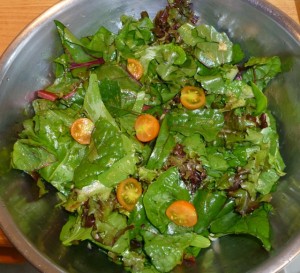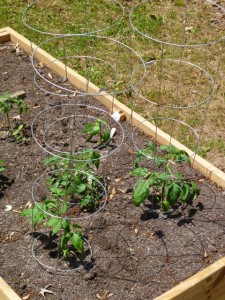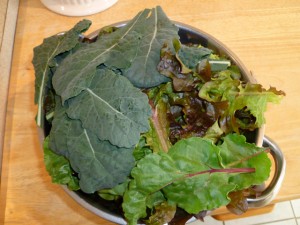Archived posts by category: Gardening
foodscout blog
One Year of Gardening: What Is Easy, What Is Hard
Just over a year ago, we put in our first back yard, raised bed garden. At this point, we are still not experts, still have more unsuccessful plants than successful ones, and are still frequently overwhelmed by all that we do not know.
But one thing we have learned over the last year is which vegetables are really easy to grow, which are nearly impossible, and which fall in between, at least in our particular mountain climate in Western North Carolina. Wherever you live, it could of course be completely different.
What’s Easy:
- Greens of just about any kind, including beets, chard, lamb’s quarters, lettuces, kale, Asian greens, collards, and cilantro. The Asian greens and kale do need frequent tending to pull off cabbage worms that will annihilate a plant within days. The lettuces tend to attract aphids which can be dealt with using natural sprays.
- Snap peas. Give them some nice thin lattice to climb up and they are good to go.
- Strawberries. They need a little time to get established, but once they do, they can take over a garden bed.
- Green onions. I stuck some seeds in the ground, didn’t pay much attention, and in a few weeks I had fresh onions.
- Sun gold tomatoes (orange cherry-sized). The only tomatoes that have done well for me. This one plant grew like crazy and provided dozens of little tomatoes each week for a few months.
What’s hard:
- Tomatoes (aside from those sun golds). I tried two years in a row and both times they were destroyed by blight. That is a fungus that causes the tomatoes to rot on the vine, but it is a regional problem so you may not have to worry about it. At least this year I managed to get a half dozen brandywine tomatoes out of the garden.
- Watermelon. I was so excited to be able to grow my own fruit. When the little melons started to form on the vine, I was hopeful that this would be a success. Then the plant just shriveled up and died without warning. On the other hand, my neighbor has a front lawn composed entirely of beautiful watermelons, so I know it’s not impossible.
- Cucumbers. In two years I have managed to enjoy only 3 cucumbers from my garden. The first year they were destroyed by pickle worms. The second year the plants got some kind of fungus and died. Those 3 cukes sure were delicious though.
- Blueberries. I have killed 2 bushes and I have one that is surviving but has yet to produce a single edible berry.
- Garlic. I don’t even know what happened. It just died.
What’s hit-or-miss:
- Bell peppers. I got a few good ones last year (even though I planted them too late) and this year I have 2 plants that are producing quite a few good-looking peppers. The jury is still out but it looks promising.
- Squash. My summer squash was phenomenal and plentiful last year, until pickle worms destroyed it. When I somehow managed to accidentally plant spaghetti squash this year, it produced only a few squashes which molded before they were ready to be picked.
That’s how it’s gone for us so far. What’s important is that this year has been more successful than last year. If we can keep that trend going, we’ll be in great shape.
Summer garden planting
This year, we have the chance to do what we were too late for last year. That is the May planting. In the southern Appalachian region, early to mid-May is the time when all the below-50 degree weather is behind us.
This year, we’ve added a fourth 4X8 garden bed to our yard to make room for everything, which still doesn’t appear to be enough space!
From seed, we planted a variety of greens, peas, green onions, and cucumbers. From plant starts, we planted sun gold tomatoes, Brandywine tomatoes, purple Cherokee tomatoes, orange bell peppers, red bell peppers, lambsquarters, stevia, strawberries, and something called “moon and stars watermelon”. We also decided to try a raspberry bush this year.
Some things we are doing this year to hopefully avoid the failings of last year:
- We put a fence around our new small raspberry bush so that it does not meet the same fate of our blue berry bush which we tripped over several times.
- We are using tomato cages this year instead of stakes. Last year, the stakes worked OK, but we often accidentally broke off major parts of the plant when we needed to re-stake part of it. Of course, it didn’t matter in the end since all of our tomatoes succumbed to blight.
- We planted everything at the right time! Last year, we planted our summer vegetables much too late (July). I’m told that could have contributed to our tomato blight as well as the pickleworm problem we had with the cucumbers and squash.
One reason we ran out of space in the garden (we’re hoping to also plant some cantaloupe) is because some of our fall greens from last year are still producing! Greens has been the biggest success in our garden, which is great since it’s also the largest component of our regular diet.
We are still learning, and appreciate any advice you want to share with us. We have better expectations for this year than for last year. And hopefully we will learn lessons this year that will make the next planting even better still.
I heard recently someone say that it takes 3 years to really figure out what you’re doing. We’re on our way!
0 Comments | Posted by Diana | Category: Gardening
Spring Planting in the Foodscout Garden
Winter is finally over! The sun has been out and we haven’t seen sub-freezing temperatures in at least a week. Time to plant our early spring vegetables! Here’s what’s happening in our southern Appalachian area garden. If you live in a different climate, like Arizona for instance, you will need to look at what grows at this time in your area.
Our beets, red lettuce, tat soi, and collards made it through the very tough winter with a lot of help from our portable greenhouse tent. Once the air started heating up, the greens began to really flourish again. Additionally, some seeds that we planted much too late last fall that we thought were wasted, actually began to sprout last week! Winter lettuce and arugula is coming up.
To add to what we’ve got in place, we’re planting some good early spring seeds. Snow peas, chard, dino (lacinato) kale, more beets, and green bunching onions.
You’ll notice that our garden is really heavy on the greens. There are 2 reasons for that:
- We eat TONS of greens, typically in the form of a green smoothie every night for dinner and
- Greens do very well during these colder months.
The fruit vegetables, such as tomatoes and cucumbers, will have to wait for another month or two.
Update: On a walk around the neighborhood today, I stopped by a neighbor’s house who was getting rid of some strawberry plants after thinning out her garden. So I went ahead and planted some strawberries in one of my garden beds, as well as incorporating a few in random places throughout my front yard landscaping. We’ll see how they do.
0 Comments | Posted by Diana | Category: Gardening
Mini Greenhouse Tent Saves Greens From Snow Storm
 About a foot of snow fell this weekend in Asheville. Power was out for 15 hours, stores and restaurants were closed, and cars were snowed in for days. But we had fresh garden greens this weekend from our garden.
About a foot of snow fell this weekend in Asheville. Power was out for 15 hours, stores and restaurants were closed, and cars were snowed in for days. But we had fresh garden greens this weekend from our garden.
Our StarterHouse portable greenhouse by FlowerHouse arrived just in time. We’ve had it up for over a week, trying to decide if we ought to get more for the other beds. There are various brands as well as do-it-yourself plans available, but this one was cost-effective at $80, and it just happened to fit our 4′X8′ garden perfectly.
It does have some drawbacks. The most notable is that it collapsed under the weight of a foot of snow. Had we not caught it right away, it could have done major damage to our plants. On the bright side, after clearing the snow off of it, it easily popped right back up again quite easily. So in the future, we’ll make sure to clear off accumulating snow after a few inches fall.
 Another minor hassle is that the zippers can be hard to open and close when it is below freezing because ice can form. This is a pain, but worth the trouble considering the benefits.
Another minor hassle is that the zippers can be hard to open and close when it is below freezing because ice can form. This is a pain, but worth the trouble considering the benefits.
In colder climates, it’s possible that this tent would not protect plants adequately from the cold. It’s perfect for our area in the North Carolina mountains.
After this weekend, we are very pleased with this product and will order a second one so that we can keep more greens growing during the winter.
We make absolutely no money from FlowerHouse. We just really like this product.
5 Comments | Posted by Diana | Category: Gardening
Harvesting Unripe Peppers
 We planted our red sweet peppers quite a bit late in the season. My plants produced a lot of peppers but did not have a chance to fully ripen before the first frost came and withered all the leaves.
We planted our red sweet peppers quite a bit late in the season. My plants produced a lot of peppers but did not have a chance to fully ripen before the first frost came and withered all the leaves.
My gardening advisor suggested we go ahead and harvest the peppers, since they were already pretty large.
Definitely, they are not as tasty as they should be. They are slightly bitter and not as crispy as they should be. But they are still pretty good and definitely have that same refreshing taste that all home grown food seems to have.
Now that the peppers and other summer vegetables are gone, there’s space to plant some more winter greens. I’ve just added winter lettuce and arugula to my garden beds.
0 Comments | Posted by Diana | Category: Gardening
Tiny Urban Gardens Wherever They Will Fit
 I spend a lot of time walking around my neighborhood. I used to enjoy the pretty landscaping, but over the past year or so, a significant change has happened. More and more neighbors are turning their yards into vegetable gardens; finding any patch of earth that gets sunlight and planting food.
I spend a lot of time walking around my neighborhood. I used to enjoy the pretty landscaping, but over the past year or so, a significant change has happened. More and more neighbors are turning their yards into vegetable gardens; finding any patch of earth that gets sunlight and planting food.
This is an older neighborhood so there are many wonderful huge trees, which means a lot of yards are too shady to grow food. That hasn’t deterred some from planting their gardens in less conventional places. Back yards, hidden behind fences, are no longer the only place you can put a garden.
Entire front yards are now replaced with rows of leafy greens. Steep hillsides are turned into terraced gardens. And my personal favorite: 4 neighbors got together and built raised garden beds in the “right of way” area between the sidewalk and the road.
You could take this explosion of urban vegetable gardening as a negative sign; highlighting our lack of faith in the future of our food supply. You could also take it as a positive sign; that a rapidly growing number of people are taking control of their health and reconnecting with real wholesome food.
If you want to grow your own food, you can find a way.
Gardening and Farming on Rooftops in the big cities
 Even in the Big Apple, residents are finding ways to garden. One resident has even created a 6,000 square foot commercial organic farm, on a rooftop in Brooklyn.
Even in the Big Apple, residents are finding ways to garden. One resident has even created a 6,000 square foot commercial organic farm, on a rooftop in Brooklyn.
Learn more about Rooftop Farms, in Brooklyn NY.
Cabbage Worms – Importance of Daily Garden Checks
 I was told when I put in my garden to check it every single day for damaging insects and slugs. I enjoy my morning (and afternoon) visits to my garden so much that it was never a problem to follow through on that. But with these crazy rain storms we’ve been having here in Western North Carolina, I went more than 2 days without checking in on it.
I was told when I put in my garden to check it every single day for damaging insects and slugs. I enjoy my morning (and afternoon) visits to my garden so much that it was never a problem to follow through on that. But with these crazy rain storms we’ve been having here in Western North Carolina, I went more than 2 days without checking in on it.
What I found was my young dinosaur kale ravaged by cabbage worms. Cabbage worms are a moth larvae that love kale, which is a member of the same family as cabbage. They are almost the same exact color as young leafy greens so you have to really look to see them. I found more than a dozen happily eating away all of the new leaves, leaving only green stalks sticking up.
But all is not lost. I removed them. The next day I went back out and removed a dozen more. The third day there were only a couple, which is pretty normal.
New leaves are growing in and I will have beautiful kale soon enough. I will not neglect my garden again; come rain, hail, sleet, or snow.
My chard was also attacked, but by slugs. The chard is so large and strong already that the slugs didn’t do much damage. I removed them to what I call “slughaven”. I can’t help it – I’m sentimental about slugs for some reason. I can’t bear to cause them harm.
2 Comments | Posted by Diana | Category: Gardening
Tomato Blight in the Southeast Mountains
 There’s been a lot of news lately about late blight hitting tomato crops in the north east. Sadly, the same has happened here in the mountains of Western North Carolina, where temperatures are a little cooler than most of the Southeast.
There’s been a lot of news lately about late blight hitting tomato crops in the north east. Sadly, the same has happened here in the mountains of Western North Carolina, where temperatures are a little cooler than most of the Southeast.
We planted our tomatoes late so we never managed to get a single edible fruit before late blight hit our tomato plants. Several beautiful large green tomatoes were forming and we were so looking forward to watching them to turn red.
At first, I noticed the leaves on certain branches were wilting and turning brown. I diligently cut them off and assumed the rest of the plant was fine. But then a new group of leaves did the same, and it continued that way just about every day. When the tomatoes started forming brown rotten-looking spots on them and literally molded while still on the vine, I figured something was seriously wrong.
It didn’t take much research to discover that my tomatoes fell prey to late blight. I tried to save the plants but I had to finally pull them out this morning. So few branches were even left and there was no way they were going to recover. I’ll try again for fresh tomatoes next year.
Local food shopping – trade produce with your neighbors
A new website called Veggie Trader is now available for any zipcode in the U.S., provided all you gardeners sign up and participate. Veggie Trader allows you to barter your back yard garden produce with your neighbors. Wondering what to do with all those tomatoes? Maybe your neighbor wants some. Make a few bucks on the side or trade for some peppers or squash or whatever you are lacking.
Our foodscout garden has provided us with some tasty veggies, but not yet enough to have excess. We’ve signed up our foodscout garden anyway though.
Veggie Trader is just getting started. Help get it going and thousands of others will be sure to join in.
0 Comments | Posted by Diana | Category: Articles, Gardening



